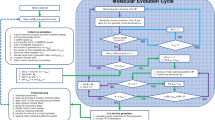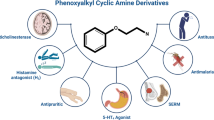Abstract
Infection with hepatitis B virus (HBV) is a major cause of liver diseases such as cirrhosis and hepatocellular carcinoma. In our previous studies, we identified indole derivatives that have anti-HBV activities. In this study, we optimize a series of 5-hydroxy-1H-indole-3-carboxylates, which exhibited potent anti-HBV activities, using three-dimensional quantitative structure-activity relationship (3D QSAR) studies with comparative molecular field analysis (CoMFA) and comparative molecular similarity indices analysis (CoMSIA). The lowest energy conformation of compound 3, which exhibited the most potent anti-HBV activity, obtained from systematic search was used as the template for alignment. The best predictions were obtained with the CoMFA standard model (q 2 = 0.689, r 2 = 0.965, SEE = 0.082, F = 148.751) and with CoMSIA combined steric, electrostatic, hydrophobic and H-bond acceptor fields (q 2 = 0.578, r 2 = 0.973, SEE = 0.078, F = 100.342). Both models were validated by an external test set of six compounds giving satisfactory prediction. Based on the clues derived from CoMFA and CoMSIA models and their contour maps, another three compounds were designed and synthesized. Pharmacological assay demonstrated that the newly synthesized compounds possessed more potent anti-HBV activities than before (IC50: compound 35a is 3.1 μmol/l, compound 3 is 4.1 μmol/l). Combining the clues derived from the 3D QSAR studies and from further validation of the 3D QSAR models, the activities of the newly synthesized indole derivatives were well accounted for. Furthermore, this showed that the CoMFA and CoMSIA models proved to have good predictive ability.





Similar content being viewed by others
References
Ganem D (2004) Hepatitis B virus infection–natural history and clinical consequences. New Engl J Med 350:1118–1129
Rerknimitr RMK, Nusont MB, Mahachai V, Kullavanijaya P (2004) Result of endoscopic biliary drainage in hilar cholangiocarcinoma. J Clin Gastroenterol 38:518–523
Humphries JSD (2003) Antivirals for the treatment of chronic hepatitis B:current and future options. Intervirology 46:413–420
Woodland AM (2006) Entecavir:a new nucleoside analog for the treatment of chronic hepatitis B Infection. Pharmacotherapy 26:1745–1757
Colonno RJR, Baldick CJ, Levine S, Podornowski K, Yu CF, Walsh A, Fang J, Hsu M, Mazzucco C, Eggers B, Zhang S, Plym M, Klesczewski K, Tenney DJ (2006) Entecavir resistance is rare in nucleoside naïve patients with hepatitis B. Hepatology 44:1656–1665
Chai HF, Zhao YF, Zhao CS, Gong P (2006) Synthesis and in vitro anti-hepatitis B virus activities of some ethyl 6-bromo-5-hydroxy-1H-indole-3-carboxylates. Bioorg Med Chem 14:911–917
Zhao CS, Zhao YF, Chai HF, Gong P (2006) Synthesis and in vitro anti-hepatitis B virus activities of some ethyl 5-hydroxy-1H-indole-3-carboxylates. Bioorg Med Chem 14:2552–2558
Zhao CS, Zhao YF, Chai HF, Gong P (2006) Synthesis and in vitro anti-hepatitis B virus activities of several ethyl 5-hydroxy-1H-indole-3-carboxylates. Chem Res Chin Univ 22:577–583
aSYBYL [computer program]. Version 6.8. St Louis (MO):Tripos Associates
Ghose A, Crippen G (1986) Atomic Physicochemical parameters for three-dimensional structure-directed quantitative structure-activity relationships I. Partition coefficients as a measure of hydrophobicity. J Comput Chem 7:565–577
Monti SA (1966) The Nentizescu condensation of ethyl 3-aminocrotonate and 1, 4-benzoquinone. J Org Chem 31:2669–2672
Grinev AN, Pershin GN (1990) 5-hydroxyindole-3-carboxylates derivatives and their use. WO 9008135
Sells MA, Chen ML, Acs G (1987) Production of hepatitis B virus particles in Hep G2 cells transfectd with cloned hepatitis B virus DNA. Proc Natl Acad Sci USA 84:1005–1009
Sells MA, Zelent AZ, MGAcs S (1988) Replicative intermediates of hepatitis B virus in HepG2 cells that produce infectious virions. J Virol 62:2836–2844
Korba BE, Gerin JL (1992) Use of a standardized cell culture assay to assess activities of nucleoside analogs against hepatitis B virus replication. Antivir Res 19:55–70
Korba BE, Gerin JL (1995) Antisense oligonucleotides are effective inhibitors of hepatitis B virus replication in vitro. Antivir Res 28:225–242
Lv ZL, Sheng CQ, Wang TT, Zhang YK, Liu J, Feng JL, Sun HL, Zhong HY, Niu CJ, Li K (2010) Design, synthesis, and antihepatitis B virus activities of novel 2-pyridone derivatives. J Med Chem 53:660–668
Zhang Q, Jiang ZY, Luo J, Liu JF, Ma YB, Guo RH, Zhang XM, Zhou J, Chen JJ (2009) Anti-HBV agents. Part 2:synthesis and in vitro anti-hepatitis B virus activities of alisol A derivatives. Bioorg Med Chem Lett 19:2148–2153
Acknowledgments
We greatly thank the helpful comments on this manuscript from Dr. Daniela Fera from the University of Pennsylvania. We gratefully acknowledge financial support from the National Natural Science Foundation of China (Grant 30901844 and 20972174), the Science and Technology Foundation of Guizhou Province (Grant [2008]2142 and [2008]2253), the State Key Program of Basic Research of China grant (2009CB918502), Shanghai Committee of Science and Technology grant (10410703900 and 0843190800), National S&T Major Project (2009ZX09501-001), State Key Laboratory Grant (SIMM1004KF-15) and Guangdong Science and Technology Department (2010A030100006).
Author information
Authors and Affiliations
Corresponding author
Additional information
Hui-fang Chai, Xin-xia Liang, Lin Li and Chun-shen Zhao contributed equally to this work.
Rights and permissions
About this article
Cite this article
Chai, Hf., Liang, Xx., Li, L. et al. Identification of novel 5-hydroxy-1H-indole-3-carboxylates with anti-HBV activities based on 3D QSAR studies. J Mol Model 17, 1831–1840 (2011). https://doi.org/10.1007/s00894-010-0873-7
Received:
Accepted:
Published:
Issue Date:
DOI: https://doi.org/10.1007/s00894-010-0873-7




